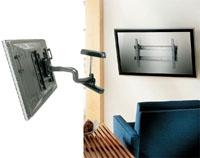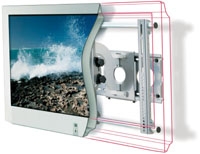Plasma Partners Page 2
PREPARE TO MOUNT

Mark Van Gessel installed the plasma on the living-room wall himself. If you decide to take on the project, make sure the framing is strong enough for the weight of your flat-panel TV. "With the bigger screens, you might have to add reinforcement," notes Bruce Garipay, president of the custom-installation firm Electronic Concierge of Phoenix, Arizona, and Puerto Vallarta, Mexico. "To put the plasma where the homeowner wanted it to be, we've cut out drywall and put in extra framing. For homes with steel studs, you usually have to add wooden bracing perpendicular to the studs. There's also a special mount for concrete-block homes."
If the arrangement of your wall studs won't let you put your flat-panel TV where you want it, tilting mounts from companies like Chief, OmniMount, Peerless, and Sanus ($200 to $700) offer extra installation flexibility. "With these mounts, the bracket the plasma attaches to can slide about a foot or so right or left," Garipay says (see above).
These companies also offer articulating or cantilevered mounts ($200 to $800) that let you pull the TV away from the wall and turn it to either side. Garipay points out that "if the plasma is mounted in a living room or family room and there's an adjacent kitchen or dining nook, you can position the TV so it's visible in the other room." The Van Gessels' set, for example, can be turned so they can watch it in the kitchen.

Another concern is getting power to your TV without having a thick cord hanging down the wall. "With new construction, you can address that with the contractor," explains Jack Mixon, co-owner of Ensemble Audio in Nashua, New Hampshire. "But it's more of an issue with an existing home." One solution is to place an electrical junction box in the wall behind the TV. "We like to locate the electrical source and other A/V connections behind the plasma for a minimalist look," says Garipay.
He recommends concealing the wiring in the wall when you mount the set. "You want to get the wiring into the drywall behind the display and then bring it out where the rest of the components are," he said. "If you have to open the wall to mount the plasma, put conduit behind it. That will let you pull any sort of cable you want in the future."
For a more integrated appearance, a flat-panel TV can be recessed into the wall so that it fits flush - but make sure the screen is properly ventilated so it doesn't overheat. "You have to be careful since the cooling fans are usually on the back of a plasma and toward the top," Garipay observes. "We usually try to dissipate the heat by creating vents that push the air away from the set or by directing it into a return duct for the house's air conditioning."




























































